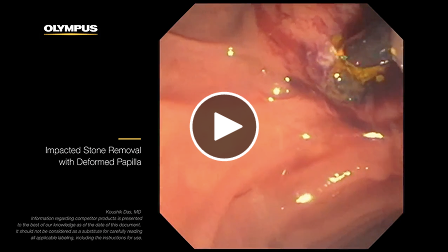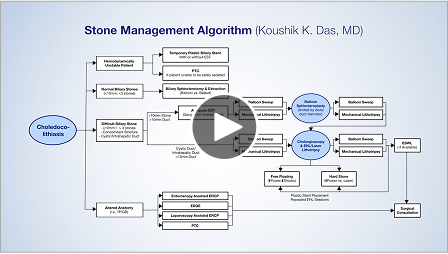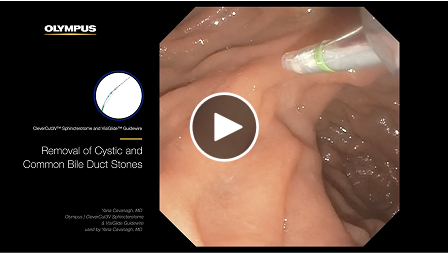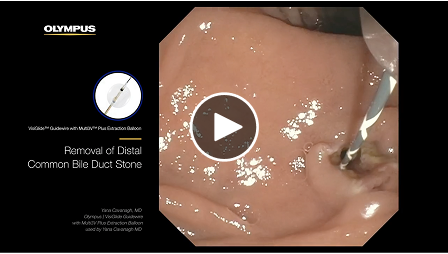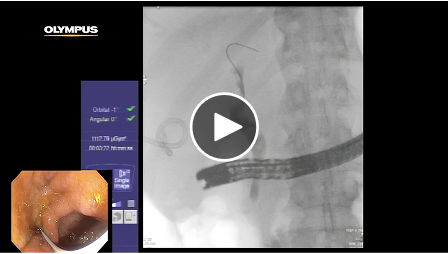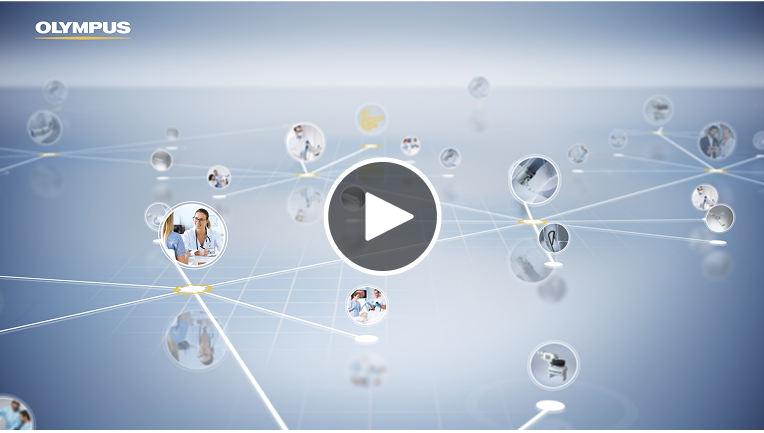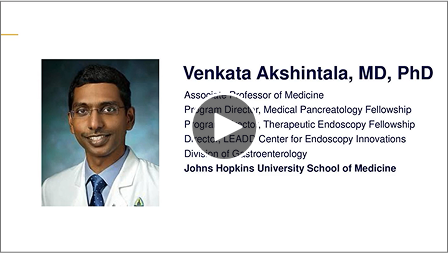Biliary Stone Management Atlas
Choledocholithiasis is the presence of stones within the common bile duct. It is estimated that common bile duct stones are present in anywhere from 1-15% of patients with cholelithiasis1. Approach to choledocholithiasis may be significantly affected by local institutional practices, availability of specific technologies, and clinical experience.
This Biliary Stone Management Algorithm by Dr. Koushik Das outlines his approach to the management of common bile duct stones.
This American Society for Gastrointestinal Endoscopy (ASGE) Standard of Practice (SOP) Guideline provides evidence-based recommendations for the endoscopic evaluation and treatment of choledocholithiasis.
Removal of Cystic and Common Bile Duct Stones
Dr. Cavanagh performs a case of mid common bile duct and cystic duct stone removal in a patient who presented with obstructive jaundice.
Removal of Distal Common Bile Duct Stone
Dr. Cavanagh performs diminutive papilla cannulation and distal CBD stone removal in a patient who presented with RUQ abdominal pain.
Did you know that the ERCP portfolio covers all necessary devices for successful ERCP? You can find technical specifications, order information and compatibilities online in our EndoTherapy catalog.
In patients with large bile duct stones, the ASGE suggests performing endoscopic sphincterotomy followed by large balloon dilation (ES-LBD) rather than endoscopic sphincterotomy (ES) alone.
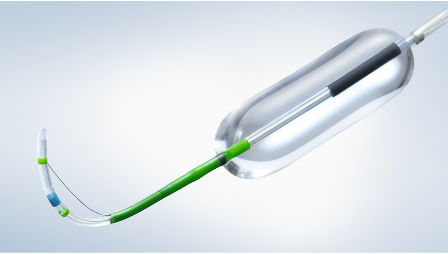
The StoneMasterV™ sphincterotome and dilation balloon combines sphincterotomy and papillary dilation into a single endoscopic device, improving efficiency by eliminating the need for device exchange, and simplifying biliary duct stone management.
Key Features and Benefits:
- Pre-curved distal end extrudes to a stable 11 o’clock orientation assisting with cannulation and sphincterotomy.
- CleverCut coating on the proximal end of the cutting wire minimizes damage to the surrounding tissue.
- Endoscopic center marker on dilation balloon enables positioning across papilla.

Olympus Continuum™ is our comprehensive platform designed to help broaden your clinical expertise and enhance your procedural skills. Tap into our online library of ERCP materials, including clinical reports, e-learning resources, procedure and quick reference guides, and our video library. Consider bookmarking the site to take advantage of in-person and virtual training events on the calendar spanning basic, intermediate, and advanced levels for gastroenterologists, nurses, and techs!
Watch recorded webinars of physicians as they share their clinical experiences.
ERCP is an effective medical procedure for diagnosing and treating problems in the liver, gallbladder, and biliary and pancreatic ducts. This may include pancreaticobiliary and gastrointestinal diseases such as acute and chronic pancreatitis, gallstones, inflammatory strictures, scarring and tumors.
Many gastroenterologists and medical staff regard ERCP as the supreme discipline in upper gastrointestinal endoscopy. Procedural challenges such as finding the major papilla, accessing the bile and pancreatic ducts, and the maneuvering and precise execution of therapeutic measures in the bile duct require high-level orientation skills, sensitivity and a well-practiced, set routine.
Ensuring optimal ERCP outcomes and minimizing potential patient risks such as post-ERCP pancreatitis require the successful completion of three essential phases: access, device exchange and therapy.
Every ERCP procedure presents its own unique challenges and necessities. Having a full product lineup at hand is therefore essential for optimal processes during ERCP procedures.
Olympus offers a range of guidewires and associated devices to help streamline ERCP procedures and improve patient outcomes:
- Guidewires
- Sphincterotomes
- Guidewire locking device
- Cannulas
- Needle knife
The Olympus ERCP stone management portfolio offers a variety of modalities in order to support the effective clearance of pancreatic stones:
- Extraction balloons and baskets for biliary and pancreatic stone retrieval
- Mechanical lithotriptors
- Papillary dilation balloons
- And a unique device that combines the two steps of sphincterotomy and sphincteroplasty
The stricture management portfolio is designed to enable stricture diagnosis and restore biliary flow. The Olympus product range includes:
- Uncovered metal biliary stents
- Dilation balloons
- Cytology brushes
- Grasping forceps
Finding a routine and ensuring the correct prior preparation are essential when performing ERCP. "Are ERCP training courses available?", "When is the next ERCP training course?" are frequently asked questions from health care professionals.
Olympus offers dedicated ERCP training and virtual training sessions on a regular basis through our Olympus Continuum™ education platform.
Connect with your Olympus Sales Representative
Please fill out the below form and we will connect you with your local Olympus representative who can answer your questions and provide support.
Risks associated with using the StoneMasterV™ Combination Sphincterotome and Papillary Dilation Balloon for sphincterotomy and papillary balloon include but are not limited to pancreatitis, bleeding, perforation, and cholangitis. Possible electrosurgical risks include but are not limited to: • Fulguration • Burns • Stimulation • Cardiac Arrhythmias. Data on file 17/Dec/2019
- McNicoll CF, Pastorino A, Farooq U, Froehlich MJ, St Hill CR. Choledocholithiasis. 2023 Jul 10. In: StatPearls [Internet]. Treasure Island (FL): StatPearls Publishing; 2025 Jan–. PMID: 28722990.





























